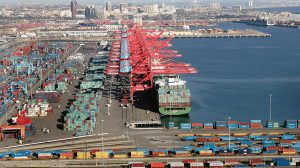 Freight rates on the primary ocean trade channels are sinking during a time typically identified as the peak season in the industry after cargo owners reportedly shipped their holiday goods early and inflation dented consumer demands.
Freight rates on the primary ocean trade channels are sinking during a time typically identified as the peak season in the industry after cargo owners reportedly shipped their holiday goods early and inflation dented consumer demands.
The cost incurred to ship a 40-foot container to the West Coast in the US from China is now about $5,400 per box, a drop of 60% from January 2022, per Freight Baltic Index.
Each container shipped to Europe from Asia now costs $9,000, which is about 42% lower than observed early in 2022. At the same time, above pandemic levels, the rate for both routes peaked at over $20,000 in September 2021.
Market conditions have made a sharp reversal from earlier in the pandemic. Freight rates jumped almost 10-fold during the previous year owing to port backlogs, surges in cargo, and supply chain disruptions. As a result, importers were found scrambling for space on the box ships. Retailers like Walmart -1.10%▼ chartered personal vessels to overcome the bottlenecks in 2021.
In 2022, Walmart and other major retailers ended up with excess inventory after they almost raced to import their goods earlier than usual, anticipating delays in shipping and demand that did not eventually materialize.
Regarding spot rates, the party is officially over, mentioned Jonathan Roach, a container shipping analyst associated with a London-based firm named Braemar. The backdrop of a possible global recession, enhanced by surging energy prices and rapid inflation, is driving down the market. The COVID-19 pandemic boom in demand for consumer products has calmed, and spending on travel, leisure, and services has reportedly made its revival since 2021.
Shipping rates are set to further ease for the remainder of the year and in 2023, per shipowners and analysts. A series of new vessels will hit the water over the next two years, with net fleet growth expected to be over 9% in 2023 and 2024. Comparatively, per Braemar, container volume growth will marginally be negative next year and could rise about 2% in 2024.
The ten largest liners have been enjoying bumper profits for the last two years. Recent quarterly earnings at Maersk. B -0.27%▼ A/S were seen to be $8.59 billion, surpassing what it usually makes in a year. But many firms have warned about the weakening market conditions in the current year’s second half.
We ought to pay attention to the impact of inflation on consumer behavior and demands, said China Cosco Shipping Corp., a firm that operates the fourth largest box ship fleet in the world. The industry’s supply side will likely encounter a unique situation with the changes in new vessels’ delivery.
Shipping analysts and executives have said that they do not expect freight rates to return to what was prevalent in the pre-pandemic levels. Part of the reason would be higher fuel costs. In 2019, the average price to send a container across the Pacific to the West Coast in the US was about $1,500.
References: Live Mint, The Wall Street Journal
